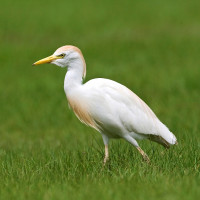Description
In the forest of Belle-Branch all the species of Woodpeckers from the department of Mayenne nest: Желна, Зелёный дятел, Большой пёстрый дятел , Малый пёстрый дятел and Средний пёстрый дятел. You will also be able to observe the Полевой лунь nesting in the regenerating plots, where Обыкновенный козодой, Обыкновенная овсянка, Серая славка are also found. Look for the Чёрный коршун and the Обыкновенный осоед which are present in the area. On the pond of Curécy (private site) you will find during the breeding season the Малая белая цапля, the Красноголовый нырок, the Хохлатая чернеть, the Чомга, the Лысуха. You will hear the singing of the Иволга, the Обыкновенная горлица and the Многоголосая камышевка which can be observed around the pond. More occasionally, the Золотистая цистикола and the Обыкновенный жулан have already nestled on the site.
In the fall, look for migrating birds stopping over on the Curécy pond and its surroundings: Мухоловка-пеструшка, Камышевка-барсучок, Вертишейка, Пеночка-весничка, Чёрный аист , Скопа and then depending on the water levels the shorebirds and waders are regular! More rare birds that have been observed are Белохвостый песочник, Погоныш, Варакушка and many others.
In winter, many granivorous passerines come to feed on the site, note the presence of Обыкновенный дубонос (also a breeder) and Юрок. From the observatory you will be able to observe the Anatidae, maybe hear the Водяной пастушок shout. At the end of the day you can attend the Египетская цапля dormitory gathering on the island of the pond.
In the spring watch for the pre-nuptial migrants, the first Деревенская ласточка, Воронок, Береговушка come to feed above the pond, not far away a Чеглок could present itself for capture one while waiting for the emergence of the first dragonflies. The Скопа migrates to reach its breeding site just like the Белый аист. Take a look at the tail of the pond from the dike, maybe a Чирок-трескунок has stopped there.
_________________________
Français: Forêt domaniale de Belle-branche et l'étang de Curécy, un complexe de milieux bocagers et zones-humides. Plus de 230 espèces d'oiseaux y ont été observées. La forêt domaniale de Belle-branche, est principalement constitué de Hêtraie-chenaie où toutes les espèces de Pics du département de la Mayenne y nichent : Желна, Зелёный дятел, Большой пёстрый дятел, Малый пёстрый дятел et Средний пёстрый дятел . Vous pourrez également observer le Полевой лунь nicheur dans les parcelles en régénération, où se trouvent aussi Обыкновенный козодой, Обыкновенная овсянка, Серая славка ... Cherchez le Чёрный коршун et la Обыкновенный осоед qui sont présent dans le secteur. Sur l'étang de Curécy (site privé) vous trouverez en période de reproduction l' Малая белая цапля, le Красноголовый нырок, le Хохлатая чернеть, le Чомга, la Лысуха ... Vous ne passerez pas à côté du chant du Иволга, de la Обыкновенная горлица et de l' Многоголосая камышевка qui sont observables autour de l'étang. Plus ponctuellement la Золотистая цистикола et la Обыкновенный жулан ont déjà niché sur le site.
A l'automne cherchez les migrateurs en halte sur l'étang de Curécy et ses pourtours : Мухоловка-пеструшка, Камышевка-барсучок, Вертишейка, Пеночка-весничка, Чёрный аист, Скопа et puis selon les niveaux d'eau les limicoles et échassiers y sont réguliers ! Plus rarement y ont déjà été observés Белохвостый песочник, Погоныш, Варакушка et bien d'autres ...
L'hiver de nombreux passereaux granivores viennent se nourrir sur le site notons la présence de Обыкновенный дубонос (également nicheur) et de Юрок. Depuis l'observatoire vous pourrez observer les anatidés, peut-être entendre crier le Водяной пастушок . En fin de journée vous pourrez assister au rassemblement du dortoir de Египетская цапля sur l'île de l'étang.
Au printemps guettez les migrateurs pré-nuptiaux, les premières Деревенская ласточка, Воронок, Береговушка viennent se nourrir au dessus de l'étang, non loin un Чеглок pourrait se présenter pour en capturer une en attendant l'émergence des premières libellules. Le Скопа passe en migration pour rejoindre son site de reproduction tout comme la Белый аист. Jettez un coup d'oeil en queue d'étang depuis la digue, peut-être qu'une Чирок-трескунок s'y est arrêté.
Details
Access
The site is located near the Meslay-du-Maine / Sablé-sur-Sarthe road axis. Park in the main car park along the D235, (click on the P in the map to get directions) then take the forest paths on foot and follow the footpath that leads to the ornithological observatory of Curécy to the south of the pond.
_________________________
Français: Le site se situe à proximité de l'axe routier Meslay-du-Maine/ Sablé-sur-Sarthe. Garez-vous sur le parking principal le long de la D235 (cliquez sur le P sur la carte pour obtenir les directions), puis empruntez à pied les allées forestières et suivez le sentier pédestre qui mène à l'observatoire ornithologique de Curécy au sud de l'étang.

.jpg)

.jpg)
